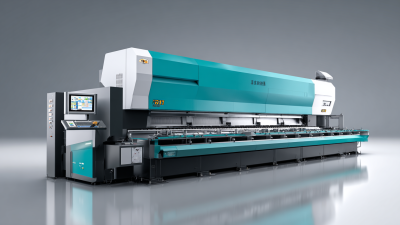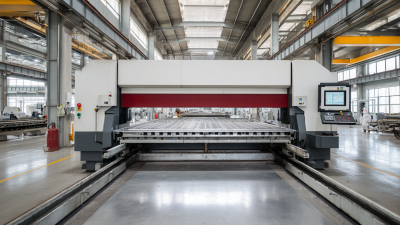Why Small Press Brakes Are Essential for Precision Metal Bending in Modern Manufacturing
In today's rapidly evolving manufacturing landscape, precision metal bending has emerged as a critical capability that influences the quality and efficiency of various products. Central to achieving this precision is the role of small press brakes, which provide unparalleled accuracy and control in bending operations. These compact yet powerful machines allow manufacturers to handle intricate designs and tight tolerances that larger equipment often struggles to replicate.
 As industries demand increasingly sophisticated components, the necessity for reliable and flexible bending solutions becomes paramount. Small press brakes not only streamline production processes but also mitigate material waste, resulting in both cost savings and enhanced sustainability. This article explores why small press brakes are essential tools in modern manufacturing, examining their advantages and the key role they play in facilitating advancements in precision metal bending.
As industries demand increasingly sophisticated components, the necessity for reliable and flexible bending solutions becomes paramount. Small press brakes not only streamline production processes but also mitigate material waste, resulting in both cost savings and enhanced sustainability. This article explores why small press brakes are essential tools in modern manufacturing, examining their advantages and the key role they play in facilitating advancements in precision metal bending.
The Importance of Small Press Brakes in Precision Metal Bending
Small press brakes play a crucial role in precision metal bending, especially in modern manufacturing environments where accuracy and efficiency are paramount. These compact machines are designed to handle smaller, intricate parts that larger equipment cannot manage effectively. Their build allows for more precise control over bending angles and dimensions, leading to higher quality finished products. As industries trend towards customization and small batch production, the demand for such precise machinery continues to rise.

Moreover, utilizing small press brakes enhances the workflow within manufacturing processes. Their size and mobility make them versatile tools that can be easily integrated into production lines without requiring significant floor space. This flexibility enables manufacturers to quickly adapt to changing project requirements and reduce setup times, resulting in increased productivity. Furthermore, small press brakes often come equipped with advanced features like programmable controls and automated systems, further enhancing their capability to produce detailed and complex metal components with consistent precision.
Key Advantages of Using Small Press Brakes in Manufacturing Processes
Small press brakes are becoming increasingly crucial in modern manufacturing, particularly for precision metal bending applications. One of the key advantages of utilizing small press brakes is their efficiency in handling smaller batches with high precision. According to a report by the Fabricators and Manufacturers Association (FMA), manufacturers that have integrated smaller press brakes into their operations saw a 25% increase in production speed while maintaining tight tolerances of ±0.002 inches. This precision is essential for industries that rely on intricate metal components, such as aerospace and automotive sectors.
Another significant benefit is the versatility small press brakes offer. They can easily accommodate a variety of materials and bending requirements, making them suitable for custom jobs and prototypes. A study by Market Research Future projects that the small press brake market will grow at a CAGR of over 4% from 2021 to 2027, emphasizing their rising importance. By investing in these tools, manufacturers can adapt quickly to changing market demands and trends.
Tips for optimizing the use of small press brakes include regularly calibrating the equipment to ensure accuracy and training operators extensively on best practices. Additionally, evaluating the specific bending requirements before selecting tooling can help in achieving the desired results while minimizing material waste. Implementing these strategies will enhance productivity and product quality in metal bending processes.

Innovative Technologies in Small Press Brake Design for Enhanced Precision
Innovative technologies in small press brake design have significantly enhanced precision in metal bending, revolutionizing the manufacturing landscape. The integration of advanced control systems, such as CNC (Computer Numerical Control), has enabled manufacturers to achieve tolerances as tight as ±0.005 inches. This level of precision is critical for industries requiring exact specifications, such as aerospace and automotive, where even minute discrepancies can lead to costly errors. According to the Fabricators & Manufacturers Association (FMA), the adoption of advanced press brakes has led to a 30% increase in overall efficiency and a reduction in material waste by up to 20%, highlighting their importance in modern manufacturing.
To optimize the performance of small press brakes, consider the following tips: First, regular maintenance and calibration of equipment are essential to ensure accurate bending and prevent tool wear. Second, invest in training for operators to familiarize them with the latest technologies and control systems, enhancing their ability to produce high-quality components. Lastly, keep abreast of industry trends and advancements, as ongoing innovations in small press brake design will continue to improve functionality and efficiency, enabling manufacturers to stay competitive in a rapidly evolving marketplace.
Comparison of Small Press Brakes and Traditional Bending Methods
In modern manufacturing, the choice between small press brakes and traditional bending methods significantly impacts precision and efficiency. Small press brakes offer advanced automation and greater control, allowing for intricate bends with tighter tolerances. Their compact design makes them ideal for small-scale production and complex geometries that larger machines may struggle to handle. This increased versatility enables manufacturers to respond swiftly to market demands and customize products more effectively.
On the other hand, traditional bending methods often rely on manual processes or less flexible machinery, which can lead to inconsistencies in quality and longer production times. While they may be suitable for simpler tasks, the limitations in adjusting settings and accommodating various materials can hinder overall productivity. As manufacturing technologies evolve, small press brakes stand out as a more reliable solution that not only improves precision but also enhances operational efficiency, making them essential in today's competitive landscape.
Future Trends in Small Press Brake Applications within Modern Manufacturing
In recent years, the demand for small press brakes in modern manufacturing has surged as companies pursue greater precision in metal bending. Future trends indicate an increased integration of automation and artificial intelligence into small press brake systems, enabling more consistent and accurate outputs. These technologies will streamline the production process, reducing material waste and minimizing human error, thus enhancing overall operational efficiency.
Moreover, as the industry shifts towards sustainable manufacturing practices, small press brakes are expected to incorporate eco-friendly materials and energy-efficient designs. This aligns with the broader movement towards reducing the carbon footprint of manufacturing processes. Enhanced adaptability in design will also be a key focus, allowing small press brakes to handle a wider variety of materials and thicknesses. This versatility will cater to the growing demand for customized and small-batch production, which is becoming increasingly prevalent in sectors such as automotive and aerospace manufacturing.
Related Posts
-

Exploring the Future of Press Brake Machines at the 138th Canton Fair 2025: Industry Insights and Trends
-

Craftsmanship Redefined Chinese Manufacturing Delivering the Best Press Brake Solutions Worldwide
-

Discover the Excellence of China's Leading Factory for the Best Small Press Brake Solutions Worldwide
-

Ultimate Guide to Mastering Metal Press Brake Operations for Precision Fabrication
-

Why Understanding Hydraulic Press Brakes is Essential for Modern Manufacturing
-

Mastering the Best CNC Press Brake Selection Process for Global Buyers
